

Internet Addiction: A Brief Summary of Research and Practice. Pathological Video Game Use Among Youths: A Two-Year Longitudinal Study. + Author Affiliations Abstract OBJECTIVES: We aimed to measure the prevalence and length of the problem of pathological video gaming or Internet use, to identify risk and protective factors, to determine whether pathological gaming is a primary or secondary problem, and to identify outcomes for individuals who become or stop being pathological gamers.
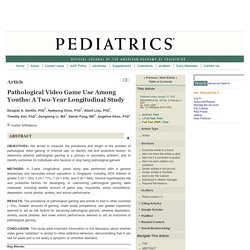
METHODS: A 2-year, longitudinal, panel study was performed with a general elementary and secondary school population in Singapore, including 3034 children in grades 3 (N = 743), 4 (N = 711), 7 (N = 916), and 8 (N = 664). Several hypothesized risk and protective factors for developing or overcoming pathological gaming were measured, including weekly amount of game play, impulsivity, social competence, depression, social phobia, anxiety, and school performance. RESULTS: The prevalence of pathological gaming was similar to that in other countries (∼9%). Key Words: Participants Measures The appendix describes the measures used. Data Analyses. Addiction à Internet. Place et rôle des usages des jeux vidéo et d'internet dans la souffrance psychologique. Sur la notion d’addiction La notion de toxicomanie, désignée en anglais par l’expression addiction to drug fut progressivement remplacée dans le discours médico-psychiatrique par la notion d’addiction.
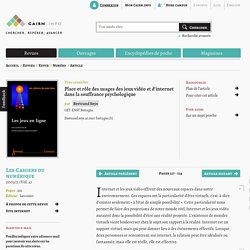
Le terme, qui désigna tout d’abord les conduites de dépendances à des substances psychoactives (alcool, drogue…), fut étendu à partir des années 1990 aux conduites de dépendances à un comportement, telle que la boulimie, la cleptomanie ou plus récemment l’addiction à internet. Cependant la notion d’addiction ne fait pas l’unanimité auprès des professionnels de la santé mentale, car sa définition reste encore aujourd’hui floue. Selon M. Valleur et J. L’adjectif « addictif » fait écho à deux situations : à la difficulté de mettre fin à une sensation particulière,à la tendance de persister dans une conduite. BENGUIGUI J. Une meilleure appréhension du concept de cyberaddiction. Addictions. Dossier réalisé en collaboration avec Bertrand Nalpas, Directeur de recherche à l’Inserm et chargé de mission Addiction – Décembre 2014 Les addictions les plus répandues concernent le tabac (nicotine) et l’alcool.
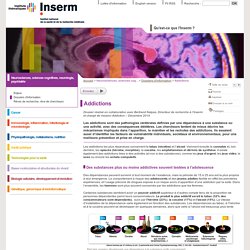
Viennent ensuite le cannabis et, loin derrière, les opiacés (héroïne, morphine), la cocaïne, les amphétamines et dérivés de synthèse. Il existe également des addictions liées à des activités (et non à des substances), comme les jeux d’argent, les jeux vidéo, le sexe ou encore les achats compulsifs. Dysfunction of the prefrontal cortex in addiction: neuroimaging findings and clinical implications : Article : Nature Reviews Neuroscience. Impaired Frontal-Basal Ganglia Connectivity in Adolescents with Internet Addiction : Scientific Reports. Subjects Twenty-eight adolescents with IA – as diagnosed by the modified Young's Diagnostic Questionnaire (YDQ) for Internet Addiction52 – and 27 well-matched healthy subjects participated in this study.

The IA subjects were outpatients of the Second Xiangya Hospital of Central South University while the controls were recruited from high schools in Changsha. All subjects (and one of their parents) received a structured clinical interview from two experienced psychiatrists, which was based on Diagnostic and Statistical Manual of Mental Disorders, Fourth Edition (DSM-IV). None of the participants in this study fulfilled any DSM-IV axis I disorders. Four healthy adolescents and 8 IA subjects were excluded from this study due to a failure to record behavioral data during the Go-Stop task.
Imbalanced functional link between executive control network and reward network explain the online-game seeking behaviors in Internet gaming disorder : Scientific Reports. Microstructure Abnormalities in Adolescents with Internet Addiction Disorder. Abstract Background Recent studies suggest that internet addiction disorder (IAD) is associated with structural abnormalities in brain gray matter.
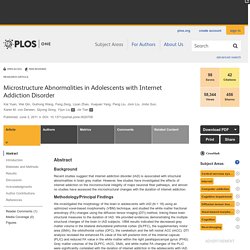
However, few studies have investigated the effects of internet addiction on the microstructural integrity of major neuronal fiber pathways, and almost no studies have assessed the microstructural changes with the duration of internet addiction. Methodology/Principal Findings We investigated the morphology of the brain in adolescents with IAD (N = 18) using an optimized voxel-based morphometry (VBM) technique, and studied the white matter fractional anisotropy (FA) changes using the diffusion tensor imaging (DTI) method, linking these brain structural measures to the duration of IAD.
Conclusions. Decreased Functional Brain Connectivity in Adolescents with Internet Addiction. Abstract Background.
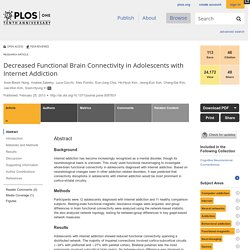
Abnormal White Matter Integrity in Adolescents with Internet Addiction Disorder: A Tract-Based Spatial Statistics Study. Abstract Background Internet addiction disorder (IAD) is currently becoming a serious mental health issue around the globe.

Previous studies regarding IAD were mainly focused on associated psychological examinations. However, there are few studies on brain structure and function about IAD. In this study, we used diffusion tensor imaging (DTI) to investigate white matter integrity in adolescents with IAD. Methodology/Principal Findings Seventeen IAD subjects and sixteen healthy controls without IAD participated in this study. Addictive Internet Use among Korean Adolescents: A National Survey. Abstract Background A psychological disorder called ‘Internet addiction’ has newly emerged along with a dramatic increase of worldwide Internet use.
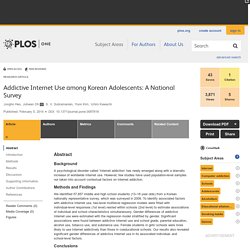
However, few studies have used population-level samples nor taken into account contextual factors on Internet addiction. Differential Psychological Impact of Internet Exposure on Internet Addicts. Abstract The study explored the immediate impact of internet exposure on the mood and psychological states of internet addicts and low internet-users.

Participants were given a battery of psychological tests to explore levels of internet addiction, mood, anxiety, depression, schizotypy, and autism traits. They were then given exposure to the internet for 15 min, and re-tested for mood and current anxiety. Internet addiction was associated with long-standing depression, impulsive nonconformity, and autism traits. Development of Korean Smartphone Addiction Proneness Scale for Youth. Development and Validation of a Smartphone Addiction Scale (SAS) Abstract Objective.
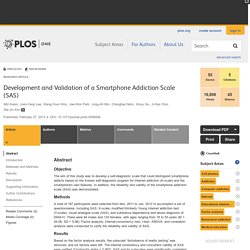
JMIR-Internet Addiction Test (IAT): Which is the Best Factorial Solution? Introduction Overview The current overview of global Internet usage provides a striking picture of the extent of the phenomenon. Because of a steady strengthening between computer technology and traditional communication processes [-], Internet users’ growth reached 566.4% from 2000 to 2012. Because the majority of online users have become members of chats, forums, and social networks, the rise and popularity of the Internet is strongly linked to its use in communication and socialization processes. For this, the medium has become an ever-increasing part of many people’s day-to-day lives [], changing the way to communicate. Mark D Griffiths - Publications.
Should DSM-V Designate “Internet Addiction” a Mental Disorder?